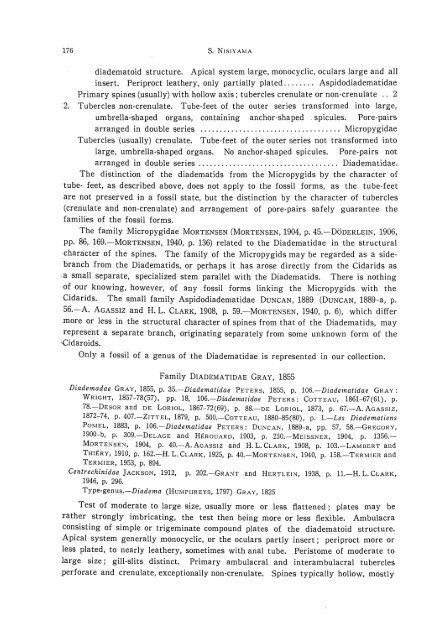the echinoid fauna from japan and adjacent regions part i
the echinoid fauna from japan and adjacent regions part i
the echinoid fauna from japan and adjacent regions part i
Create successful ePaper yourself
Turn your PDF publications into a flip-book with our unique Google optimized e-Paper software.
176 S. NISIYAMA<br />
diadematoid structure. Apical system large, monocyclic, oculars large <strong>and</strong> all<br />
insert. Periproct lea<strong>the</strong>ry, only <strong>part</strong>ially plated........ Aspidodiadematidae<br />
Primary spines (usually) with hollow axis; tubercles crenulate or non-crenulate .. 2<br />
2. Tubercles non-crenulate_ Tube-feet of <strong>the</strong> outer series transformed into large,<br />
umbrella-shaped organs, contammg anchor-shaped . spicules. Pore-pairs<br />
arranged in double series .................................... Micropygidae<br />
Tubercles (usually) crenulate. Tube-feet of <strong>the</strong> outer series not transformed into<br />
large, umbrella-shaped organs. No anchor-shaped spicules. Pore-pairs not<br />
arranged in double series .................................... Diadematidae.<br />
The distinction of <strong>the</strong> diadematids <strong>from</strong> <strong>the</strong> Micropygids by <strong>the</strong> character of<br />
-tube- feet, as described above, does not apply to <strong>the</strong> fossil forms, as <strong>the</strong> tube-feet<br />
are not preserved in a fossil state, but <strong>the</strong> distinction by <strong>the</strong> character of tubercles<br />
(crenulate <strong>and</strong> non-crenulate) <strong>and</strong> arrangement of pore-pairs safely guarantee <strong>the</strong><br />
families of <strong>the</strong> fossil forms.<br />
The family Micropygidae MORTENSEN (MORTENSEN, 1904, p. 45.-DoDERLEIN, 1906,<br />
pp. 86, 169.-MoRTENSEN, 1940, p. 136) related to <strong>the</strong> Diadematidae in <strong>the</strong> structural<br />
-character of <strong>the</strong> spines. The family of <strong>the</strong> Micropygids may be regarded as a sidebranch<br />
<strong>from</strong> <strong>the</strong> Diadematids, or perhaps it has arose directly <strong>from</strong> <strong>the</strong> Cidarids as<br />
a small separate, specialized stem parallel with <strong>the</strong> Diadematids. There is nothing<br />
of our knowing, however, of any fossil forms linking <strong>the</strong> Micropygids with <strong>the</strong><br />
Cidarids. The small family Aspidodiadematidae DUNCAN, 1889 (DUNCAN, 1889-a, p.<br />
56.-A. AGASSIZ <strong>and</strong> H. L. CLARK, 1908, p. 59.-MoRTENSEN, 1940, p. 6), which differ<br />
more or less in <strong>the</strong> structural character of spines <strong>from</strong> that of <strong>the</strong> Diadematids, may<br />
represent a separate branch, originating separately <strong>from</strong> some unknown form of <strong>the</strong><br />
'Cidaroids.<br />
Only a fossil of a genus of <strong>the</strong> Diadematidae is represented in our collection.<br />
Family DIADEMATIDAE GRAY, 1855<br />
Diademadae GRAY, 1855, p. 35.-Diadematidae PETERS, 1855, p. 106.-Diadematidae GRAY:<br />
WRIGHT, 1857-78(57), pp. 18, 106.-Diadematidae PETERS: COTTEAU, 1861-67(61), p.<br />
78.-DESOR <strong>and</strong> DE LORIOL, 1867-72(69), p. 88.-DE LORIOL, 1873, p. 67.-A. AGASSIZ,<br />
1872-74, p. 407.-ZITTEL, 1879, p. 500.-COTTEAU, 1880-85(80), p. l.-Les Diadematiens<br />
POMEL, 1883, p. 106.-Diadematidae PETERS: DUNCAN, 1889-a, pp. 57, 58.-GREGORY,<br />
1900-b, p. 309.-DELAGE <strong>and</strong> HEROUARD, 1903, p. 230.-MEISSNER, 1904, p. 1356.<br />
MORTENSEN, 1904, p. 40.-A. AGASSIZ <strong>and</strong> H. L. CLARK, 1908, p. 103.-LAMBERT <strong>and</strong><br />
THIERY, 1910, p. 162.-H. L. CLARK, 1925, p. 40.-MoRTENSEN, 1940, p. 158.-TERMIER <strong>and</strong><br />
TERMIER, 1953, p. 894.<br />
Centrechinidae JACKSON, 1912, p. 202.-GRANT <strong>and</strong> HERTLEIN, 1938, p. ll.-H. L. CLARK,<br />
1946, p. 296.<br />
Type-genus.-Diadema (HUMPHREYS, 1797) GRAY, 1825<br />
Test of moderate to large size, usually more or less flattened; plates may be<br />
ra<strong>the</strong>r strongly imbricating, <strong>the</strong> test <strong>the</strong>n being more or less flexible. Ambulacra<br />
consisting of simple or trigeminate compound plates of <strong>the</strong> diadematoid structure.<br />
Apical system generally monocyclic, or <strong>the</strong> oculars <strong>part</strong>ly insert; periproct more or<br />
less plated, to nearly lea<strong>the</strong>ry, sometimes with anal tube. Peristome of moderate to<br />
large size; gill-slits distinct. Primary ambulacral <strong>and</strong> interambulacral tubercles<br />
perforate <strong>and</strong> crenulate, exceptionally non-crenulate. Spines typically hollow, mostly












